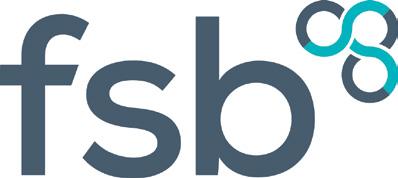A SHARES FOR DEBT RECOVERY PLAN
Converting Bounce-back loans into employee equity
Nigel Mason




The last year has been incredibly difcult for all businesses as a result of the repeated lockdowns and the inability to operate as they so wish they could. Businesses have found themselves loading up debt in order to survive and protect jobs. In many instances, these debt levels have now become unsustainable.
Now that the economy is beginning to reopen, businesses are seeing the potential to return to normal operations. However, for many small businesses, the return to normal is accompanied by a very heavy debt burden that they will soon have to make repayments on. Anything the government can do to alleviate the burdens faced by small businesses will go a long way to aid economic recovery, sustain jobs, boost the overall confdence of business owners and free up additional fnance for future investments.
The Ofce for Budget Responsibility’s worst case scenario estimates that £34 billion of BBLS and CBILS loans could default. Many small businesses will be contemplating whether it is worth carrying on with their levels of debt, or if it is worth starting again. Phoenixing could well become a serious issue post COVID.
In times of adversity, we must look for opportunity. Employee ownership is associated with greater efciency, faster growth, and a motivated workforce. The FSB and Ownership at Work’s proposal, outlined in this paper, would mean that employee ownership can receive a boost, while avoiding some viable businesses going under. Writing off the debt for small businesses in return for employee stakes in the business means that balance sheets instantly become healthier, jobs are maintained, and businesses get the boosts associated with employee ownership.
Not all businesses will opt for this route as many will be able to adequately pay off their debt burdens. Likewise, many owners do not want to give up stakes in their businesses. However, this proposal is not zero-sum, rather we are hoping it can be used alongside other measures to ensure that companies are given the best opportunities to recover, and importantly thrive, in the months and years to come.
 Martin McTague
Martin McTague
Ownership at Work’s mission is to generate new thinking and ideas on employee ownership’s contribution to the UK economy. An independent think tank, Ownership at Work publishes policy papers, guidance and research on the fastest growing business model in the UK economy. Holding charitable status, Ownership at Work is a politically impartial research partner of the Employee Ownership Association, the national body which speaks for the UK’s £30 billion employee ownership sector.
Equity for All – how a simple trust can spread ownership and wealth to millions
Capital Partners? – why it’s time for fnance and employee ownership to talk
Redesigning the CEO – how employee ownership changes the art of leadership
A Partnership Fund for Jobs – how government can help small business cope with the crisis
Redesigning Work – employee owners speak
Build back together – a recovery that works for everyone
The Federation of Small Businesses (FSB) is the UK’s leading business organisation. Our mission is to help smaller businesses achieve their ambitions. Established over 40 years ago, we are a non-proft making and non-party political organisation that’s led by our members, for our members. As experts in business, we offer our members a wide range of vital business services, including legal advice, fnancial expertise, access to fnance, support, and a powerful voice in government. Our expert teams work with governments, elected members and decisionmakers across England, Scotland, Wales and Northern Ireland, at both a national and local level.

Nigel Mason is a senior associate at RM2, having previously been owner and managing director. A mathematician by training, his early career was in banking. He became interested in employee ownership following a study tour of employee owned companies in the USA. Inspired by their success, Nigel started a number of businesses in the UK to advise and support new employee owned businesses. He advised the government on the introduction of the Share Incentive Plan and EMI share option scheme in 2000, and in 2014 advised the Coalition government on the introduction of the employee ownership trust, the subject of this paper.
RM2 is a 25 year old consulting business specialising in employee share schemes and employee ownership trusts for private companies. The multi-disciplinary team of lawyers, accountants, tax specialists and administrators helps clients design, install, fnance and operate their employee ownership plans to maximum effect. As well as advising clients, RM2 staff do extensive pro bono work in the employee ownership sector, contributing their know-how through publications, blogs, policy papers, webinars and statistical analyses. RM2 became wholly owned by its employees in 2019.
This paper develops a policy idea to relieve small businesses of their post-pandemic unsustainable debt burden by converting the Government’s Bounce Back loans into an all-employee equity stake. This would be achieved by way of a time-limited amnesty granted to qualifying borrowers under which loans are written off in exchange for an employee equity stake vested in an Employee Ownership Trust.
This would give small businesses a double boost: less debt and the transformative power of employee ownership.
The Employee Ownership Association and its charitable research partner, Ownership at Work, have been developing policy ideas with the Federation of Small Businesses (FSB), the infuential membership organisation representing SMEs, to help relieve businesses of their post-pandemic debt burden by converting unsustainable debt into employee equity.
One EOT-related idea was included in the FSB’s policy paper “A Fighting Chance” in December 2020 (https://www.fsb.org.uk/resources-page/afghting-chance-december-2020-pdf.html). Because of the transaction costs involved in establishing EOTs and assigning debt from banks to EOTs, that idea was necessarily aimed at larger companies which have borrowed more than £250,000 under the Coronavirus Business Interruption Loan Scheme (CBILS).
FSB have now requested an alternative, simpler idea which would appeal to the thousands of smaller companies that have borrowed under the Bounce Back Loan Scheme (BBLS). This would involve banks writing off BBLS loans (and claiming under their 100% government guarantee) in return for the forgiven borrower establishing an allemployee equity stake of meaningful value.
The Bounce Back Loan Scheme has proved to be the most popular of the Government’s business support loan schemes. As of March 2021, £46.5 billion had been advanced under 1.5 million facilities (some businesses may have more than one facility if they have one or more subsidiaries).
This represents 62% of all money advanced under the Government loan schemes and 94% of all loan facilities. The scheme was open until 31 March 2021.
Just under 90% of loans by value are with the top fve banks. This is a helpful concentration when it comes to promoting any new idea for employee ownership.
We have not been able to fnd much data on the characteristics of BBLS borrowers, e.g. number of employees and trade sector distribution but eligibility criteria for borrowing are very broad and extend to sole traders and partnerships, so there will be a lot of micro-enterprises amongst the borrowers, some with no employees other than the founders. There is data on geographic distribution, which shows borrowers are as widely distributed as SMEs generally.
Any trading business in existence in March 2020 which had not already taken out a CBILS loan could borrow between £2,000 and £50,000 subject to a maximum of 25% of turnover. There were no credit checks. The criteria were deliberately loose so as to speed up the process of draw-down.
Unfortunately, this has probably resulted in widespread fraud.
Loans originally had a six year term with a one year repayment holiday. Interest is charged at 2.5% per annum with effect from month 13. The term has since been extended to ten years and borrowers are allowed to ask for up to three capital repayment holidays of up to six months and one full repayment holiday (capital and interest) of up to six months.
From the outset of the scheme, there have been predictions of widespread defaults because of the challenges facing SMEs in sectors such as retail, hospitality and leisure and because of the “light touch” approach taken by the lenders, at the Government’s insistence.
City UK estimated in July 2020 that 33% of borrowers had unsupportable debt, affecting businesses employing 3 million people. The OBR goes further and estimates that 40% of borrowers will be in default and that the Government may have to write off up to £34 billion in their worst-case scenario. This is an astonishingly large number and, if it materialises, will become a major political issue.
One challenge for the Government is that the debt recovery process has not yet been worked out fully. The 100% Government guarantee weakens the incentive for lenders to take costly action against thousands of tiny businesses which the banks know has little prospect of success and will lose them goodwill in the market. Furthermore, lenders can claim on the Government guarantee without having completed the debt recovery process.
Various remedies have been proposed. For example, City UK has proposed converting a BBLS loan into a tax obligation, rather like a student loan becomes repayable when the borrower is earning above a certain threshold.
“Some arrangements will have to be made. A lot of them will be written off or converted into something else. In most cases the idea of the government taking equity in these companies is unrealistic — they are simply too small. So the question is what’s going to happen to all of these loans?”
Unnamed Chairman of Top 5 bank, reported in The Financial Times 31 May 2020
Commenting on the wider dilemma, Jonathan Ford wrote in The Financial Times on 17 July 2020 that the Chancellor essentially had to decide between “forgiveness and forbearance”. Bankruptcies or converting loans into grants might be forms of forgiveness but would create political risks. Putting off making decisions risked supporting “zombie companies”.
In July 2020, the Chancellor expressed doubt to the Treasury Committee about the wisdom of taking an equity stake in “millions of very small businesses”. He added that the Treasury was “open to interesting ideas that we think might help drive the recovery. As you know, many different institutions, bodies and think tanks continue to come up with ideas and send them our way; we will happily take a look at them.”

The simple idea proposed by FSB is that a time-limited amnesty is granted to qualifying BBLS borrowers under which loans are written off in exchange for the borrower establishing an all-employee equity stake of meaningful value. This overcomes the likely objection to unconditional forgiveness of Bounce Back loans: business owners will not be the only benefciaries of a loan write-off.
Ownership at Work has convened a working party of technical experts1 to turn this concept into a practical, detailed proposal which can be implemented quickly with no requirement for new legislation. Details are provided in Appendix 1.
Employee ownership, properly structured and communicated, has the power to transform employee engagement in a business, as the many adopters of Employee Ownership Trusts are discovering. Employee ownership leads to greater resilience, fexibility and resourcefulness. The evidence for this was documented in EOA’s landmark 2018 study, The Ownership Dividend.2
Wider employee ownership in SMEs will also contribute to the government’s other policy objectives, such as “levelling up” the regional economies, including more people in the wealth creation process and anchoring businesses in their local economy. The political and economic case for employee ownership is expounded in Appendix 2.

Will this proposal favour SMEs at the expense of other sectors of the economy? As a sector, SMEs are the biggest employer in the UK. The government has invested so much so far in preserving jobs (e.g. the furlough scheme) that it makes sense to try to maximise the prospects of that investment achieving its objectives.
How can companies be made accountable for setting up the employee ownership stake? In choosing to accept the amnesty, borrowers will agree via a dedicated website to certain terms and conditions, compliance with which will be monitored by a public trustee. Companies will be required to communicate the existence of the employee equity stake to their employees.
Will forgiving debt in SMEs create more opportunities for fraud?
It is true that the light touch approach to Bounce Back loan approvals appears to have led to fraudulent applications. Arguably, the incentive for further fraud has now passed. Rogue borrowers who have no intention of repaying the loan are unlikely to take this further step of creating an employee equity stake.
Will forgiving debt in companies that can’t afford to repay it simply perpetuate zombie companies? Even if the write-off of the Bounce Back loan prolongs the life of a company by only a few months, it will have preserved jobs that might otherwise have disappeared, at greater expense to the taxpayer. Companies going bust and increasing unemployment will reduce individuals’ willingness to spend and this will hold back the expected recovery.
Will EOTs mean the banks receive very little repayment of the crisis loans, potentially costing the government billions? According to the OBR’s worst case scenario, the government will have to write off up to £34 billion of bad debt. Under our proposal, businesses that may have defaulted will continue to pay taxes and support jobs.

A time-limited amnesty for BBLS borrowers in exchange for employee equity stakes would deliver a powerful double boost to thousands of SMEs - less debt and the transformative power of employee ownership - and protect millions of jobs. We have provisionally called this policy idea the BOOST programme. We look forward to working with government and stakeholders on the detail of implementation as soon as possible.

To qualify for the amnesty, borrowers must be constituted as companies limited by shares. There is no immediate requirement for the business to have employees other than founders, so the scheme could be extended to very small companies. However, sole traders and partnerships would not be immediately eligible until an equivalent scheme is devised (see i) below). Generally, in order to minimise transaction costs, the criteria for eligibility for the amnesty will need to be as “light touch” as the original BBLS borrowing criteria.
It is not practical to grant employee share awards to individual employees as this will create too much administration. Instead, the vehicle for employee ownership should be the tried and tested Employee Ownership Trust which is well defned in Schedule 37 of the Finance Act 2014 and which must operate on an all-employee basis. The advantage of creating an equity stake based on trust law is that it provides protection and helpful guidance underpinned by the centuries-old principles of “equity” and “fduciary duty”.
It is not practical to carry out at scale bespoke valuations of the equity of small companies in order to calculate what size of equity stake should be created for the EOT. Instead, some simple rules of thumb are needed. This will be crude and will inevitably create winners and losers, but the amnesty is being offered on a “take or leave” basis. We propose a standard 10% EOT stake – the widely accepted threshold for employee share schemes in large public companies – on a fully diluted basis. As consideration for the loan write-off, the EOT would be allotted new issue shares of the best available class. Shares would be allotted at par value, creating a share premium account.
BBLS borrowers wishing to use the scheme would access a gov.uk or British Business Bank website to accept the terms and conditions of the scheme, including agreeing to pass any necessary resolutions, make any necessary changes to Articles and communicating the scheme to employees. The website would include standard documentation for the EOT set-up and access to guidance on how to run the scheme to get the best out of employee ownership. Arrangements for the participating banks to recover their loan writeoff from the government guarantee are beyond the scope of this paper.
So far, most EOTs have been controlled by trustee companies established by their founding company, with trustee directors drawn from employees, founders and sometimes external advisers. We do not think this is practical to achieve at scale in very small businesses, who are unlikely to be able to afford the administration costs, including trustees’ and advisers’ fees.
Instead, we propose that all trustee arrangements should be vested in a newly created public body, the “Employee Ownership Trustee Corporation”, like Law Debenture Corporation or the Public Trustee, with companies paying a modest annual fee to defray costs. The role of this public trustee, which will be largely inactive until there is a corporate action such as a dividend payment, a capital restructuring or an exit event, is to ensure compliance with the EOT legislation, to ensure fair treatment of its minority shareholding position and to monitor for possible abuse.
The trustee can monitor public disclosures (e.g. mandatory Companies House flings) to ensure compliance with the terms and conditions which the company accepted in order to participate (see d) above).
If successful, companies using the scheme will one day be in a position to pay dividends. In this case, the EOT would qualify for its 10% share of any dividend pay-out. The EOT will have granted a dividend waiver so long as the company pays bonuses under PAYE of equivalent value to all employees on similar terms, as specifed by the EOT legislation. The company’s directors would have discretion as to how precisely this is allocated. Employees who are participators (i.e. employees who are or were in the last ten years 5% or more shareholders) should not be included in the EOT dividend pay-out. If there are no benefciaries, the trustee would collect the dividend for onward remittance to HM Treasury. This would represent partial recovery of the government’s initial write-off of the BBLS loan.
The company may one day be sold or liquidated, or the company may propose a buyback at fair value of the EOT stake. In these scenarios, the proceeds would be distributed by the company – under the trustee’s supervision – to all employees on similar terms, as required by the EOT legislation. The company’s directors would have discretion as to how precisely this is allocated. Employees who are participators cannot be included in the distribution. If there are no benefciaries, the trustee would remit the proceeds to HM Treasury.
The EOT was conceived as an exit route for business owners. If shareholders together sell a controlling interest to an EOT, they beneft from full relief from Capital Gains Tax and employees qualify for bonuses free of income tax. It is possible that this scheme will lead to many more EOTs being established as exit routes in successful small businesses. Note that the two tax reliefs are only available to companies that pass a minimum size test: participators must represent no more than 40% of total employees. For example this would mean a minimum of fve employees in companies with two founder shareholders. Nevertheless, even companies that are too small to access the tax reliefs may conclude that the EOT is a far better succession solution than liquidation or trade sale.
If the government felt it important to make the amnesty available to all BBLS borrowers, including sole traders and partnerships, it could substitute a special purpose vehicle for the EOT. The SPV would be entitled to 10% of the sole trader’s earnings or of a partnership’s profts. The SPV would require more work and we would recommend that implementation of the scheme is not delayed for this as the EOT is ready for immediate implementation and will cover many hundreds of thousands of SMEs.
In the past decade, three factors have been particularly responsible for stimulating growth of the employee ownership sector:
• 2012 – The Nuttall Review3 – a Coalition Government commissioned independent review which reported on 26 recommendations to increase levels of employee ownership.
• 2014 - Employee Ownership Trust (EOT)4 - introduced the new model as part of the Finance Bill 2014 offering capital gains tax relief for founders selling their business to an EOT and tax-free dividends (up to £3,600) for individual employees. This works alongside other share schemes used by the rest of the employee ownership sector.
• 2017 - The Ownership Effect Inquiry5 - an EOA inquiry, chaired by Baroness Bowles of Berkhamsted, in which business organisations including the FSB, IoD and ICAEW concluded that employee ownership supports a more inclusive and productive economy through more engaged employees, improved productivity and the rooting of jobs in regional economies for the longer term.
Accelerated adoption of the EOT has started to change the shape and size of the total employee-owned sector in the UK.
Once only seen in a handful of large businesses such as the John Lewis Partnership, Arup, and Scott Bader, the growth in employee ownership has been mainly in SMEs and family businesses looking for a succession option as founder(s) exit the business. However, some larger, privately owned businesses including Seetec, Aardman Animations, Riverford Organics and Richer Sounds have also made the transition to secure jobs and the future of the business.
While the sector remains modest in size, estimated at about 600 employee-owned businesses, with 421 of those using the EOT, it is worth at least £30bn to the UK economy annually (3-4% of UK GDP) and the Top 50 of those businesses (by size) consistently record productivity growth - 6.9% (May 2019-May 2020) compared to -0.1% in the UK economy.
Over 50% of the growth of employee ownership has been since 20176 with key growth sectors:
• Professional, Scientifc and Technical Activities 29.1% (particularly in the built environment)
• Manufacturing 14.3%
• Information and Communication 12.2%
• Construction 11.4%
• Wholesale and Retail 9.3%
The growth of the Employee Ownership Trust since 2014
• 421 live EOTs7
• 37,500 (approx) jobs sustained or created in the UK
• EOTs represent 1 in 20 of all private company sales (others being trade sales and sales to private equity)
• 66% growth in businesses owned via an EOT has been since 2017
• 100+ businesses converting to employee ownership a year since 20198
• The pandemic has seen interest in employee ownership via an EOT grow with enquiries to the EOA and advisors (accounting and tax) recording record numbers so far in 2021
In addition to the evidence of the benefts of employee ownership outlined in the Ownership Dividend report9, the pandemic has exposed challenges for which employee ownership and the EOT can deliver specifc solutions:
• Supporting SMEs to recover by converting debt into an employee ownership stake, thereby enabling future investment.
• Protecting jobs in SMEs and family-owned businesses.
• In the longer term, enabling a reduction in wealth inequality as more employees take an ownership stake in the business in which they work, sharing in profts and capital growth.
• In the longer term, enabling higher levels of resilience in regional businesses and their local economies.
https://employeeownership.co.uk/resources/what-the-evidence-tells-us/
https://www.rm2.co.uk/resources/blog/2020-was-bumper-year-employee-ownership-trusts
www.employeeownership.co.uk/resources/reports